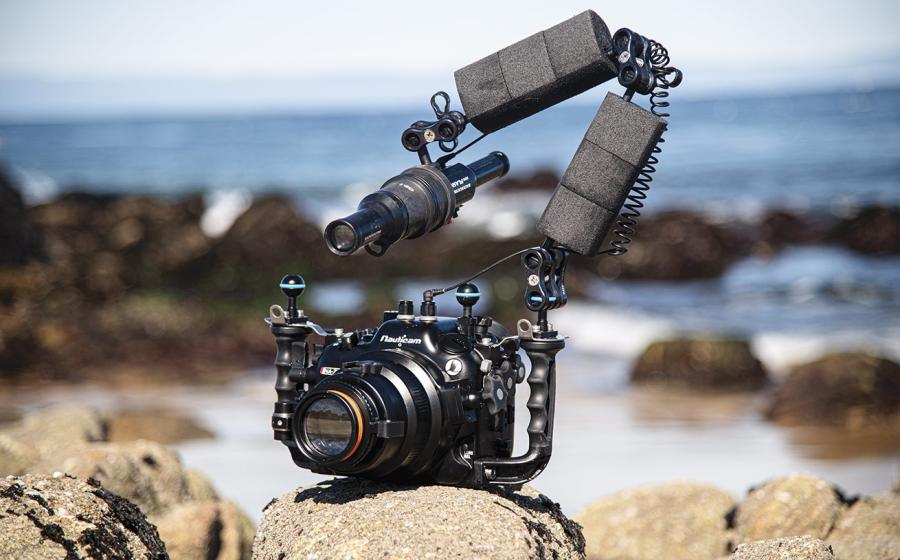Deep, Dark and Dangerous
May 2000
Setting the Stage
Ed.'s note: The incidents described here are real. Names of locations and people have been changed or deleted.
Mick was a fit and active diver who was becoming an accomplished lobster hunter. He was also an ex-smoker and non-drinker who engaged in a great deal of demanding exercise.
The Day of Diving
In the morning, Mick made several shallow dives testing some dive equipment. To monitor his air consumption, he was using a borrowed air-integrated dive computer, rather than his own non-air-integrated one. Nearly eight hours later, he switched to his own computer for a night lobster dive. The dive was made from a boat in an area where the rocky bottom sloped to nearly 200 feet. The divers had planned to work their way to the west, dropping down to around 130 feet looking for lobsters, then working their way shallower as they headed east back toward the boat.
The beginning of the dive went according to plan but, as is common among game-hunting divers, most of the diving was done solo. Near the maximum planned depth, Mick saw a good-sized lobster well below him and dropped down to bag it. He was then at 155 feet. At 1,400 psi, he moved to 80 feet and bagged several more lobsters.
Mick continued hunting, losing track of time until he was near 500 psi. During ascent, his computer warned him of required decompression, but he was unable to see or hear the warnings due to the darkness, bubbles, his hood and his need to deal with his buoyancy. As he approached 20 feet, his now low-on-air, extra-large, borrowed aluminum tank became even more buoyant than he anticipated and he popped to the surface, missing his deco stops, missing his safety stop and making a rapid ascent. Now, having surfaced more than 100 yards away from the boat, he swam in the 55-degree water with his bag of lobster back to the boat. His dive computer logged the dive as 155 feet for 28 minutes with required decompression stops at 30, 20 and 10 feet.
Decompression Illness
Fifteen minutes after surfacing, Mick started noticing some tingling and stinging, followed 10 minutes later by deep muscle pain. Later, he lost the use of his right arm and then his right leg, and he was down on the deck breathing heavily. After 20 to 30 minutes, he felt much better and was able to function again.
His friends took him to the local EMS provider, who immediately put him on oxygen and transported him to the local recompression chamber. At the chamber he was diagnosed with both decompression sickness (DCS) and arterial gas embolism (AGE). His one treatment lasted about six hours and he came away with no residual symptoms.
Analysis
What caused Mick's accident? Some risk factors are clear:
-
Multiple, missed deco stops.
-
A rapid ascent, particularly at the end of a very demanding dive.
-
Multiple dives in cold water, with lots of physical exertion.
-
Not following his dive computer.
Other factors are not as clear:
-
Did his past smoking contribute to the AGE?
-
Switching dive computers, although not a good practice, was not a direct cause, as he was well into required-decompression status on the computer he was diving at the time.
-
The earlier shallow dives occurred so long before the incident dive that they likely had little bearing. However, the earlier dives would have put his dive computer into required-decompression status sooner. Therefore, if he had used the same dive computer all day, he might not have gone as deep or stayed as long.
Lessons For Life
-
Use the same dive computer for all dives in a series.
-
Monitor your dive computer regularly and use the data displayed to make decisions in the best interests of your diving safety.
-
Do not borrow unfamiliar dive equipment for deep or demanding diving, such as the large, very buoyant aluminum tank in this case.
-
Avoid rapid ascents, particularly near the end of a dive series or at the end of a deep or demanding dive.
-
Make all required decompression stops, and then add on your safety stop after the required deco stops are completed.
May 2000
Setting the Stage
Ed.'s note: The incidents described here are real. Names of locations and people have been changed or deleted.
Mick was a fit and active diver who was becoming an accomplished lobster hunter. He was also an ex-smoker and non-drinker who engaged in a great deal of demanding exercise.
The Day of Diving
In the morning, Mick made several shallow dives testing some dive equipment. To monitor his air consumption, he was using a borrowed air-integrated dive computer, rather than his own non-air-integrated one. Nearly eight hours later, he switched to his own computer for a night lobster dive. The dive was made from a boat in an area where the rocky bottom sloped to nearly 200 feet. The divers had planned to work their way to the west, dropping down to around 130 feet looking for lobsters, then working their way shallower as they headed east back toward the boat.
The beginning of the dive went according to plan but, as is common among game-hunting divers, most of the diving was done solo. Near the maximum planned depth, Mick saw a good-sized lobster well below him and dropped down to bag it. He was then at 155 feet. At 1,400 psi, he moved to 80 feet and bagged several more lobsters.
Mick continued hunting, losing track of time until he was near 500 psi. During ascent, his computer warned him of required decompression, but he was unable to see or hear the warnings due to the darkness, bubbles, his hood and his need to deal with his buoyancy. As he approached 20 feet, his now low-on-air, extra-large, borrowed aluminum tank became even more buoyant than he anticipated and he popped to the surface, missing his deco stops, missing his safety stop and making a rapid ascent. Now, having surfaced more than 100 yards away from the boat, he swam in the 55-degree water with his bag of lobster back to the boat. His dive computer logged the dive as 155 feet for 28 minutes with required decompression stops at 30, 20 and 10 feet.
Decompression Illness
Fifteen minutes after surfacing, Mick started noticing some tingling and stinging, followed 10 minutes later by deep muscle pain. Later, he lost the use of his right arm and then his right leg, and he was down on the deck breathing heavily. After 20 to 30 minutes, he felt much better and was able to function again.
His friends took him to the local EMS provider, who immediately put him on oxygen and transported him to the local recompression chamber. At the chamber he was diagnosed with both decompression sickness (DCS) and arterial gas embolism (AGE). His one treatment lasted about six hours and he came away with no residual symptoms.
Analysis
What caused Mick's accident? Some risk factors are clear:
Multiple, missed deco stops.
A rapid ascent, particularly at the end of a very demanding dive.
Multiple dives in cold water, with lots of physical exertion.
Not following his dive computer.
Other factors are not as clear:
Did his past smoking contribute to the AGE?
Switching dive computers, although not a good practice, was not a direct cause, as he was well into required-decompression status on the computer he was diving at the time.
The earlier shallow dives occurred so long before the incident dive that they likely had little bearing. However, the earlier dives would have put his dive computer into required-decompression status sooner. Therefore, if he had used the same dive computer all day, he might not have gone as deep or stayed as long.
Lessons For Life
Use the same dive computer for all dives in a series.
Monitor your dive computer regularly and use the data displayed to make decisions in the best interests of your diving safety.
Do not borrow unfamiliar dive equipment for deep or demanding diving, such as the large, very buoyant aluminum tank in this case.
Avoid rapid ascents, particularly near the end of a dive series or at the end of a deep or demanding dive.
Make all required decompression stops, and then add on your safety stop after the required deco stops are completed.










